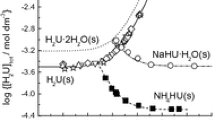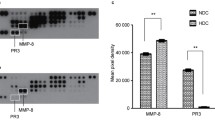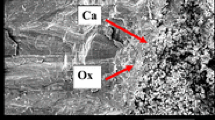Summary
Previous ultrafiltration studies indicated that up to one-half of the calcium and two-thirds of the phosphate in human salivary secretions may be bound by salivary proteins. Since this binding is an important variable in determining the extent of salivary supersaturation with respect to calcium phosphate salts, and since the amount of binding reported is surprisingly large, calcium and phosphate ion-binding by salivary macromolecules has been reexamined. From experiments using equilibrium dialysis, it was found that (1) the fraction of salivary calcium involved in macromolecular complexes ranges from a few percent for unstimulated secretions, to no more than about 10% for stimulated glandular salivas, and (2) salivary proteins do not bind phosphate ions to any significant extent. These findings, and experiments using an improved ultrafiltration membrane, indicate that the earlier results were artifacts of the ultrafiltration technique. Fractionation of salivary proteins, followed by equilibrium dialysis measurements, showed that the anionic proline-rich proteins and a basic proline-rich glycoprotein are responsible for most of the calcium binding now observed. The finding that macromolecular complexes of salivary calcium and phosphate have been overestimated in the past, leads to the conclusion that salivary calcium and phosphate ion activities in stimulated salivary secretions may be up to 50 to 100% higher than previously thought. Revised values were therefore used to recalculate the degree of salivary supersaturation with respect to calcium phosphate salts. The results indicate that stimulated salivary secretions are supersaturated with respect to dicalcium phosphate dihydrate; this is a substantially greater degree of supersaturation than previously reported.
Similar content being viewed by others
References
Hay DI, Schlesinger DH, Moreno EC (1979) Phosphoprotein-inhibitors of calcium phosphate precipitation from human salivary secretions. Inorg. Persp. Biol. and Med. 2:271–285
Gron P (1973) The state of calcium and inorganic orthophosphate in human saliva. Arch Oral Biol 18:1365–1378
Oppenheim FG (1970) Preliminary observations on the presence and origin of serum albumin in human saliva. Helv Odont Acta 14:10–17
Shannon IL, Chauncey HH (1967) A parotid fluid collection device with improved stability characteristics. J Oral Ther Pharm 4:93–97
Lowry OH, Rosebrough NJ, Farr AL, Randall RJ (1951) Protein measurements with the Folin phenol reagent. J Biol Chem 193:265–275
Davies BJ (1964) Disc electrophoresis II. Method and application to human serum proteins. Ann NY Acad Sci 121:404–427
Gindler EM, King JD (1972) Rapid colorimetric determination of calcium in biologic fluids with methylthymol blue. Amer J Clin Path 58:376–382
Lowry OH, Lopez JA (1946) The determination of inorganic phosphate in the presence of labile phosphate esters. J Biol Chem 162:421–428
Aslyng HC (1954) The lime and phosphate potentials of soils, the solubility and availability of phosphates. Yearbook Royal Vet and Agr Coll Copenhagen:1–50
Hagen AR (1965) On the Behavior of Dental Enamel in Inorganic Salt Solutions, PhD thesis. University of Oslo
Moreno EC, Gregory TM, Brown WE (1974) Preparation and solubility of hydroxyapatite. J. Res. Nat. Bur. Stand. (US) 72A:773–782
Gregory TM, Moreno EC, Brown WE (1970) Solubility of CaHPO4, 2H2O in the system Ca(OH)2-H3PO4-H2O at 5, 15, 25, and 37.5°C. J. Res. Nat. Bur. Stand. (US) 74A:461–475
Moreno EC (1968) Solubility and thermodynamic data on calcium phosphates. In: Young RA, Brown WE (eds) International Symposium on structural properties of hydroxyapatite and related compounds Ch. 15
Gregory TM, Moreno EC, Patel JM, Brown WE (1974) Solubility of β-Ca3(PO4)2 in the system Ca(OH)2-H3PO4-H2O at 5, 15, 25, and 37°C. J Res Nat Bur Stand (US) 78A:667–674
Gron P (1973) Saturation of human saliva with calcium phosphates. Arch Oral Biol 18:1385–1392
Bennick A, Connell GE (1971) Purification and partial characterization of four proteins from human saliva. Biochem J 123:455–464
Oppenheim FG, Hay DI, Franzblau C (1971) Proline-rich proteins from human saliva. I. Isolation and partial characterization. Biochemistry 10:4233–4238
Azen EA, Denniston CL (1974) Genetic polymorphism of human salivary proline-rich proteins: further gentic analysis. Biochem Genet 12:109–120
Hay DI, Oppenheim FG (1974) The isolation from human parotid saliva of a further group of proline-rich proteins. Arch Oral Biol 19:627–632
Levine MJ, Weill JC, Ellison SA (1969) The isolation of a glycoprotein from parotid saliva. Biochim Biophys Acta 188:165–167
Backer-Dirks O (1966) Post-eruptive changes in enamel. J Dent Res 45:503–511
Fehr FR von der Loe H, Theilade E (1970) Experimental caries in man. Caries Res 4:131–148
Bennick A (1976) The binding of calcium to a salivary phosphoprotein, Protein A, common to human parotid and submandibular secretions. Biochem J 155:163–169
Bennick A (1977) The binding of calcium to a salivary phosphoprotein, Protein C, and comparison with calcium-binding to Protein A, a related salivary phosphoprotein. Biochem J 163:241–245
Bennick A, Cannon M (1978) Quantitative study of the interaction of the salivary acidic proline-rich proteins with hydroxyapatite. Caries Res 12:159–169
Boat TF, Wiesman UN, Pallavicini JC (1974) Purification and properties of the calcium-precipitable protein in submandibular saliva of normal and cystic fibrosis subjects. Pediatric Res 8:531–539
Rolla G, Jonsen J (1967) The calcium-binding effect of a human salivary glycoprotein. Caries Res 1:343–348
Kousvelari EE, Baratz RS, Burke B, Oppenheim FG (1980) Immunochemical identification and determination of prline-rich proteins in salivary secretions, enamel pellicle, and glandular tissue specimens. J Dent Res 59:1430–1438
Stein EA, Hsiu J, Fischer EH (1964) Alpha-amylases as calcium metalloenzymes. I. Preparation of calcium-free apoamylases by chelation and electrodialysis. Biochemistry 3:56–61
Bennick A, Wong R, Cannon M (1977) Structure and biological activities of salivary acidic proline-rich phosphoproteins. In: Wasserman RH, Corradino RA, Carafoli E, Kretsinger RH, MacLennan DH, Siegal FL (eds) Calcium-binding proteins and calcium function. Elsevier, North Holland 391–400
Lagerlof F (1980) Determination of ionized calcium in parotid saliva. Clin Chim Acta 102:127–135
Maier H, Coroneo MT, Heidland A, Wigand ME (1978) Ionisiertes Calcium und Totalcalcium im Parotisspeichel bei Normalpersonen und essentiellen Hypertonikern. Laryngol Rhinolotol (Stuttg) 57:1013–1017
Ericsson Y (1949) Enamel-apatite solubility. Acta Odontol Scand 8 (Suppl 3)
Fosdick LS, Starke AC (1939) Solubility of tooth enamel in saliva at various pH levels. J Dent Res 18:417–430
Hills JE, Sullivan HR (1958) Studies on the acid decalcification of human dental enamel. II. Aust Dent J 3:101–106
Johansson B (1965) Remineralization of slightly decalcified enamel studied by polarized light microscopy. J Dent Res 44:64–70
Rathje W (1956) Oversaturation of saliva with hydroxyapatite. J Dent Res 35:245–248
Schlesinger DH, Hay DI (1977) Complete covalent structure of statherin, a tyrosine-rich acidic peptide which inhibits calcium phosphate precipitation from human parotid saliva. J Biol Chem 252:1689–1695
Zipkin I, Fath EH, Stephen RM (1953) The concentration of citrate in whole and parotid saliva. J Dent Res 32:709
Ericsson Y, Hellstrom I (1953) Lactic acid content of the saliva after carbohydrate ingestion. Source of the salivary lactic acid and inhibition of its formation. Acta Odont Scand 10:118–133
Sillen LG, Martell AE (1964) Stability constants of metalion complexes. The Chemical Society, London.
Lagerlof F, Lindquist L (1982) Distribution of bound and ionic calcium in human parotid saliva. J Dent Res 61:565
Author information
Authors and Affiliations
Rights and permissions
About this article
Cite this article
Hay, D.I., Schluckebier, S.K. & Moreno, E.C. Equilibrium dialysis and ultrafiltration studies of calcium and phosphate binding by human salivary proteins. Implications for salivary supersaturation with respect to calcium phosphate salts. Calcif Tissue Int 34, 531–538 (1982). https://doi.org/10.1007/BF02411299
Issue Date:
DOI: https://doi.org/10.1007/BF02411299




